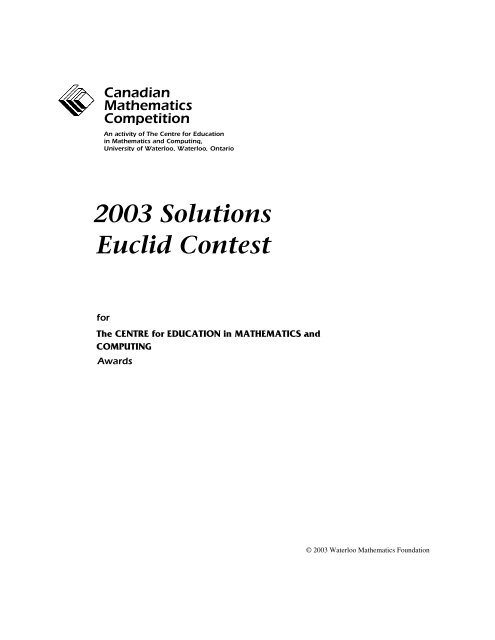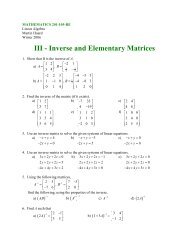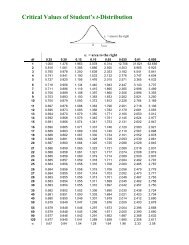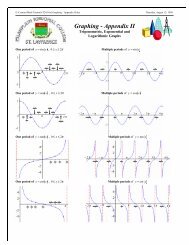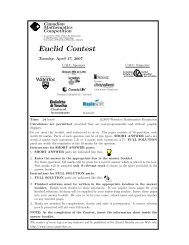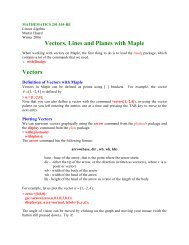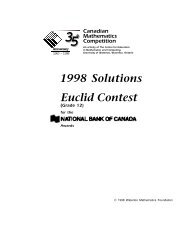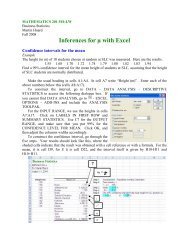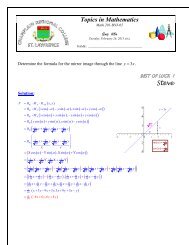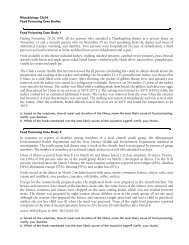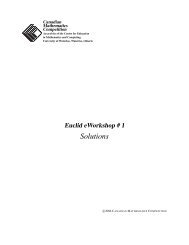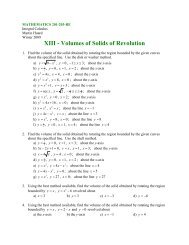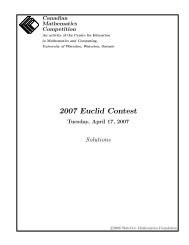2003 Solutions Euclid Contest - CEMC - University of Waterloo
2003 Solutions Euclid Contest - CEMC - University of Waterloo
2003 Solutions Euclid Contest - CEMC - University of Waterloo
Create successful ePaper yourself
Turn your PDF publications into a flip-book with our unique Google optimized e-Paper software.
CanadianMathematicsCompetitionAn activity <strong>of</strong> The Centre for Educationin Mathematics and Computing,<strong>University</strong> <strong>of</strong> <strong>Waterloo</strong>, <strong>Waterloo</strong>, Ontario<strong>2003</strong> <strong>Solutions</strong><strong>Euclid</strong> <strong>Contest</strong>forThe CENTRE for EDUCATION in MATHEMATICS andCOMPUTINGAwards© <strong>2003</strong> <strong>Waterloo</strong> Mathematics Foundation
<strong>2003</strong> <strong>Euclid</strong> <strong>Solutions</strong> 21. (a) Solution 1Since the x-intercepts <strong>of</strong> the parabola are 2 and 4, then the axis <strong>of</strong> symmetry <strong>of</strong> theparabola is x = 3.Since the point 08 ,x = 3 is the point ( 68 , ). Thus, a = 6 .( ) is on the parabola, its image after a reflection across the vertical lineSolution 2Since the x-intercepts <strong>of</strong> the parabola are 2 and 4, then the equation <strong>of</strong> the parabola is <strong>of</strong>the form y = A( x−2) ( x−4 ).Since ( 08 , ) lies on the parabola, then 8= A ( −2) ( −4)or A = 1.2Therefore, the parabola has equation y = ( x−2) ( x−4)= x − 6x+8.But the point ( a,8) lies on the parabola, so28= a − 6a+820 = a −6a0 = aa ( −6)Since a ≠ 0, then a = 6 . Answer: a = 6(b) Solution 1Since the quadratic equation has two equal roots, then the expression on the left must be aperfect square. Since the leading coefficient is 1 and the coefficient <strong>of</strong> the x-term is 6,2 2then the expression must be x+3 x 6x9. By comparing expressions, k = 9.( ) = + +Solution 2Since the quadratic equation has two equal roots, the discriminant is 0, ie.6 2 − 4()( 1 k )= 0 or 4k = 36 or k = 9. Answer: k = 92( ) lies on the parabola, so 4 = 1 − 31 ()+ c or(c) From the given information, the point 14 ,c = 6.We now find the points <strong>of</strong> intersection <strong>of</strong> the parabola and the line by equating:22x+ 2 = x − 3x+620 = x − 5x+40 = ( x−1) ( x−4)Thus the points <strong>of</strong> intersection have x-coordinates x = 1 and x = 4.Substituting x = 4 into the line y = 2x+2, we get the point ( 410 , ).Therefore, the second point <strong>of</strong> intersection is ( 410 , ).
<strong>2003</strong> <strong>Euclid</strong> <strong>Solutions</strong> 32. (a) Rearranging the equation,o3sin( x)= cos( 15 )sin1 o( x)= 3cos( 15 )sin ( x)≈0.3220Using a calculator, x ≈18.78o . To the nearest tenth <strong>of</strong> a degree, x = 18.8o .oAnswer: x = 18.8(b) Solution 1Since sinC = AB , then AB = ACsinC= 203( )= 12AC5.2 2 2 2 2By Pythagoras, BC = AC − AB = 20 − 12 = 256 or BC = 16 .A12B20CSolution 2Using the standard trigonometric ratios, BC = AC cos C .Since sinC = 3 5, then cos2 C = 1− sin 2 C = 1− 9 = 1625 25or cosC = 4 5. (Notice that cosC ispositive since angle C is acute in triangle ABC.)Therefore, BC = 204( 5 )= 16. Answer: BC = 16(c) Let G be the point where the goat isstanding, H the position <strong>of</strong> the helicopterwhen the goat first measures the angle, Pthe point directly below the helicopter atthis time, J the position <strong>of</strong> the helicopterone minute later, and Q the point directlybelow the helicopter at this time.75°J222 mH222 mG6°QPUsing the initial position <strong>of</strong> the helicopter, tan( 6 o)= HPUsing the second position <strong>of</strong> the helicopter, tan( 75 o)= JQPG or PG = o( ) ≈So in the one minute that has elapsed, the helicopter has travelled2112. 19 m − 59.48 m = 2052.71 m or 2.0527 km.222tan 62112.19 m.222otan 7559.48 m.QG or QG = ( ) ≈Therefore, in one hour, the helicopter will travel 6 123 1620 2.0527 km( )= . .Thus, the helicopter is travelling 123 km/h.
<strong>2003</strong> <strong>Euclid</strong> <strong>Solutions</strong> 43. (a) Since we are looking for the value <strong>of</strong> f (), 9 then it makes sense to use the given equationand to set x = 3in order to obtain f()= 9 2f()+ 3 3.So we need to determine the value <strong>of</strong> f (). 3 We use the equation again and set x = 0since we will then get f () 3 on the left side and f () 0 (whose value we already know) onthe right side, ie.f()= 3 2f()+ 0 3= 2()+ 6 3=15Thus, f 9 2 15 3 33()= ( )+ = . Answer: f ()= 9 33(b) Solution 1We solve the system <strong>of</strong> equations for f( x) and gx ( ).Dividing out the common factor <strong>of</strong> 2 from the second equation, we get2f( x)+ 2g( x)= x + 2.Subtracting from the first equation, we get gx ( )= x+4.2 2 2Thus, f( x)= x + 2− 2g( x)= x + 2− 2( x+4)= x −2x−6.Equating f( x) and gx ( ), we obtain2x −2x− 6= x+42x −3x− 10 = 0( x−5) ( x+2)=0Therefore, x = 5 or x =−2 .Solution 2Instead <strong>of</strong> considering the equation f( x)= g( x), we consider the equationf( x)− g( x)= 0 , and we try to obtain an expression for f( x)− g( x) by manipulating thetwo given equations.In fact, after some experimentation, we can see thatf( x)− g( x)= 22 ( f( x)+ 4g( x))− 3( f( x)+ 3g( x))2 2= 22 ( x + 4)− 3( x + x+6)2= x −3x−102So to solve f( x)− g( x)= 0 , we solve x −3x− 10 = 0 or ( x−5) ( x+2)=0. Therefore,x = 5 or x =−2 .4. (a) Solution 1We label the 5 skaters A, B, C, D, and E, where D and E are the two Canadians.There are then 5!= 5 × 4 × 3 × 2 × 1 = 120 ways <strong>of</strong> arranging these skaters in their order <strong>of</strong>finish (for example, ADBCE indicates that A finished first, D second, etc.), because thereare 5 choices for the winner, 4 choices for the second place finisher, 3 choices for thethird place finisher, etc.
<strong>2003</strong> <strong>Euclid</strong> <strong>Solutions</strong> 5If the two Canadians finish without winning medals, then they must finish fourth andfifth. So the D and E are in the final two positions, and A, B and C in the first three.There are 3!= 6 ways <strong>of</strong> arranging the A, B and C, and 2!= 2 ways to arrange the D andE. Thus, there are 6× 2 = 12 ways or arranging the skaters so that neither Canadian winsa medal.Therefore, the probability that neither Canadian wins a medal is# <strong>of</strong> ways where Canadians don' t win medals 12 1= =Total # <strong>of</strong> arrangements120 10Solution 2We label the 5 skaters as A, B, C, D, and E, where D and E are the two Canadians. Inany race, two <strong>of</strong> the skaters finish fourth and fifth. Also, any pair <strong>of</strong> skaters are equallyas likely to finish fourth and fifth, since the probability <strong>of</strong> every skater is equally likely t<strong>of</strong>inish in a given position.How many pairs <strong>of</strong> 2 skaters can we form from the 5 skaters? There are ten such pairs:{A,B}, {A,C}, {A,D}, {A,E}, {B,C}, {B,D}, {B,E}, {C,D}, {C,E}, {D,E}Only one <strong>of</strong> these ten pairs is made up <strong>of</strong> the two Canadians. Therefore, the probabilityis 110 , since one out <strong>of</strong> ten choices gives the desired result. Answer: 110(b) Solution 1Since the least common multiple <strong>of</strong> 3, 5, 10 and 15 is 30, then we can count the number<strong>of</strong> positive integers less than or equal to 30 satisfying these conditions, and multiply thetotal by 10 to obtain the number less than 300. (This is because each group <strong>of</strong> 30consecutive integers starting with 1 more than a multiple <strong>of</strong> 30 will have the samenumber <strong>of</strong> integers having these properties, because we can subtract 30 from each oneand not change these properties.)So from 1 to 30, we have:3, 5, 6, 9, 12, 18, 21, 24, 25, 27Thus there are 10 less than or equal to 30, and so 100 such positive integers less than orequal to 300.Solution 2We proceed by doing a (careful!) count.The number <strong>of</strong> positive multiples <strong>of</strong> 3 less than or equal to 300 is 100.The number <strong>of</strong> positive multiples <strong>of</strong> 5 less than or equal to 300 is 60.Thus, we have 160 candidates, but have included multiples <strong>of</strong> 15 twice (since 15 is amultiple <strong>of</strong> each <strong>of</strong> 3 and 5), and have also included multiples <strong>of</strong> 10.The number <strong>of</strong> multiples <strong>of</strong> 15 less than or equal to 300 is 20, so to remove the multiples<strong>of</strong> 15, we must remove 40 from 160 to get 120 positive integers less than or equal to 300which are multiples <strong>of</strong> 3 or 5 but not <strong>of</strong> 15.
<strong>2003</strong> <strong>Euclid</strong> <strong>Solutions</strong> 6This total still included some multiples <strong>of</strong> 10 that are less or equal to 300 (but not all,since we have already removed 30, for instance).In fact, there are 30 multiples <strong>of</strong> 10 less than or equal 300, 10 <strong>of</strong> which are multiples <strong>of</strong>15 as well (that is, the multiples <strong>of</strong> 30). So we must remove 20 from the total <strong>of</strong> 120.We then obtain that there are 100 positive integers less than or equal to 300 which aremultiples <strong>of</strong> 3 or 5, but not <strong>of</strong> 10 or 15.5. (a) Since the signs alternate every three terms, it makes sense to look at the terms in groups<strong>of</strong> 6.The sum <strong>of</strong> the first 6 terms is 1 + 3 + 5 −7 −9 − 11 = − 18.The sum <strong>of</strong> the next 6 terms is 13 + 15 + 17 −19 −21 − 23 = − 18.In fact, the sum <strong>of</strong> each group <strong>of</strong> 6 terms will be the same, since in each group, 12 hasbeen added to the numerical value <strong>of</strong> each term when compared to the previous group <strong>of</strong>6, so overall 12 has been added three times and subtracted three times.Since we are looking for the sum <strong>of</strong> the first 300 terms, then we are looking at 50 groups<strong>of</strong> 6 terms, so the sum must be 50( −18)=− 900.Answer: −900(b) Let the two digit integer have tens digit a and units digit b. Then the given informationtells us2 2a + 10b = b + 10a2 2a −b − 10a+ 10b= 0( a+b) ( a−b)−10( a−b)=0( a−b) ( a+ b−10)=0and so a = b or a+ b =10.So the possibilities for the integer are 11, 22, 33, 44, 55, 66, 77, 88, 99, 19, 28, 37, 46, 55,64, 73, 82, 91. We now must determine which integers in this list are prime.We can quickly reject all multiples <strong>of</strong> 11 bigger than 11 and all <strong>of</strong> the even integers, toreduce the list to 11, 19, 37, 73, 91.All <strong>of</strong> these are prime, except for 91 = 13 × 7.Therefore, the required integers are 11, 19, 37, and 73.6. (a) Solution 1In 24 minutes, the number <strong>of</strong> atoms <strong>of</strong> isotope A has halved 4 times, so the initial number<strong>of</strong> atoms is 2 4 = 16 times the number <strong>of</strong> atoms <strong>of</strong> isotope A at time 24 minutes.But there were initially half as many atoms <strong>of</strong> isotope B as <strong>of</strong> isotope B, so there was 8times the final number <strong>of</strong> atoms. Therefore, the number <strong>of</strong> atoms <strong>of</strong> isotope B halves 3times in the 24 minutes, so it takes 8 minutes for the number <strong>of</strong> atoms <strong>of</strong> isotope B tohalve.
<strong>2003</strong> <strong>Euclid</strong> <strong>Solutions</strong> 7Solution 2Initially, there is twice as many atoms <strong>of</strong> isotope A as <strong>of</strong> isotope B, so let the originalnumbers <strong>of</strong> atoms <strong>of</strong> each be 2x and x, respectively.Considering isotope A, after 24 minutes, if it loses half <strong>of</strong> its atoms every 6 minutes,there will be 21246x( ) atoms remaining.2241( ) atoms remaining, where TTSimilarly for isotope B, after 24 minutes, there will be x2is the length <strong>of</strong> time (in minutes) that it takes for the number <strong>of</strong> atoms to halve.From the given information,2x24246T( ) = x( )2121321212141( 2) = ( 2)( ) = ( )24T24T24= 3TT = 8Therefore, it takes 8 minutes for the number <strong>of</strong> atoms <strong>of</strong> isotope B to halve.Answer: 8 minutes(b) Solution 1AUsing the facts that log10 A+ log10 B= log10AB and that log10 A− log10 B= log10,Bthen we can convert the two equations to3 2log10( xy)=11⎛2x ⎞log10⎜3 ⎟ 3⎝ y ⎠=Raising both sides to the power <strong>of</strong> 10, we obtain3 2 11xy = 102x 33= 10yTo eliminate the y’s, we raise the first equation to the power 3 and the second to thepower 2 to obtain9 6 33x y = 104x 66= 10y9 4 13 39 33 6and multiply to obtain x x = x = 10 = 10 10 .13 39Therefore, since x = 10 , then x = 10 3 .
<strong>2003</strong> <strong>Euclid</strong> <strong>Solutions</strong> 8Substituting back into xy23 2 11= 10 , we get y 2 = 102 , and so y =±10. However,substituting into x 33= 10 we see that y must be positive, so y = 10 .yTherefore, the solution to the system <strong>of</strong> equation is x = 10 3 and y = 10 .Solution 2Since the domain <strong>of</strong> the logarithm is the positive real numbers, then the quantities3log 10 xy3( ) and log 10 ( ) tell us that x and y are positive.b( )= ( ), we rewrite the equations asUsing the fact that log10 a blog10a3log10 x+ 2log10y = 112log10 x− 3log10y = 3We solve the system <strong>of</strong> equations for log 10 x and log 10 y by multiplying the firstequation by 3 and adding two times the second equation in order to eliminate log 10 y.Thus we obtain 13log10x = 39 or log 10 x = 3.Substituting back into the first equation, we obtain log 10 y = 1.Therefore, x = 10 3 and y = 10 .7. (a) Solution 1We label the vertices <strong>of</strong> the shaded hexagon U, V, W, X,Y, and Z.By symmetry, all <strong>of</strong> the six triangles with two vertices onthe inner hexagon and one on the outer hexagon (eg.triangle UVA) are congruent equilateral triangles.In order to determine the area <strong>of</strong> the inner hexagon, wedetermine the ratio <strong>of</strong> the side lengths <strong>of</strong> the twohexagons.:Let the side length <strong>of</strong> the inner hexagon be x. Then AU = UF = x.Then triangle AUF has a 120 o between the two sides <strong>of</strong> length x.If we draw a perpendicular from U toUtheir areas is23 : 1 3 1 .point P on side AF, then UP divides60° 60°∆AUF into two 30 −60 o −90otriangles. Thus, FP = PA = 32x andxxso AF = 3 x.ASo the ratio <strong>of</strong> the side lengths <strong>of</strong> the3P Fhexagons is 3 : 1, and so the ratio <strong>of</strong>2 x 32 x( ) =Since the area <strong>of</strong> the larger hexagon is 36, then the area <strong>of</strong> the inner hexagon is 12.FxUxZAxEx x xxVYxxBxDWXC
<strong>2003</strong> <strong>Euclid</strong> <strong>Solutions</strong> 9Solution 2We label the vertices <strong>of</strong> the hexagon U, V, W, X, Y, and Z.By symmetry, all <strong>of</strong> the six triangles with two vertices onthe inner hexagon and one on the outer hexagon (eg.triangle UVA) are congruent equilateral triangles.We also join the opposite vertices <strong>of</strong> the inner hexagon, ie.we join U to X, V to Y, and W to Z. (These 3 line segmentsall meet at a single point, say O.) This divides the innerhexagon into 6 small equilateral triangles identical to thesix earlier mentioned equilateral triangles.FUaZAEBVa aa aWa a aOa aLet the area <strong>of</strong> one <strong>of</strong> these triangles be a. Then we can label the 12 small equilateraltriangles as all having area a.But triangle AUF also has area a, because if we considertriangle AFV, then AU is a median (sinceFU = AU = UV by symmetry) and so divides triangleAaAFV into two triangles <strong>of</strong> equal area. Since the area <strong>of</strong> F Y Vtriangle AUV is a, then the area <strong>of</strong> triangle AUF is also a.Therefore, hexagon ABCDEF is divided into 18 equal areas. Thus, a = 2 since the area<strong>of</strong> the large hexagon is 36.Since the area <strong>of</strong> UVWXYZ is 6a, then its area is 12.Answer: 12aYaDXC(b) We assign coordinates to the diagram, with themouth <strong>of</strong> the cannon at the point ( 00 , ), with thepositive x-axis in the horizontal direction towardsthe safety net from the cannon, and the positive y-axis upwards from ( 00 , ).Since Herc reaches his maximum height when hishorizontal distance is 30 m, then the axis <strong>of</strong>symmetry <strong>of</strong> the parabola is the line x = 30.Since the parabola has a root at x = 0, then theother root must be at x = 60.Therefore, the parabola has the formy = ax( x−60 ).In order to determine the value <strong>of</strong> a, we note thatHerc passes through the point ( 30,100), and so(30, 100)Bx = 30(0, 0) (60, 0)
<strong>2003</strong> <strong>Euclid</strong> <strong>Solutions</strong> 10( )100 = 30a−30a =−1 9Thus, the equation <strong>of</strong> the parabola is y =−1 9x x−60 .( )(Alternatively, we could say that since the parabola has its maximum point at ( 30,100),2then it must be <strong>of</strong> the form y = a( x−30) + 100.Since the parabola passes through ( 00 , ), then we have20 = a( 0 −30) + 1000 = 900a+ 1001a =−9Thus, the parabola has the equation y =− 1 ( x−) 230 + 100.)9We would like to find the points on the parabola which have y-coordinate 64, so we solve64 =− xx−60219( )0 = x − 60x+5760 = ( x−12) ( x−48)Since we want a point after Herc has passed his highest point, then x = 48, ie. thehorizontal distance from the cannon to the safety net is 48 m.8. (a) Since both the circle with its centre on the y-axis and the graph <strong>of</strong> y = x are symmetricabout the y-axis, then for each point <strong>of</strong> intersection between these two graphs, thereshould be a corresponding point <strong>of</strong> intersection symmetrically located across the y-axis.Thus, since there are exactly three points <strong>of</strong> intersection, then one <strong>of</strong> these points must beon the y-axis, ie. has x-coordinate 0. Since this point is on the graph <strong>of</strong> y = x , then thispoint must be ( 00 , ).Since the circle has centre on the y-axis (say, has coordinates ( 0,b)), then its radius isequal to b (and b must be positive for there to be three points <strong>of</strong> intersection).2 2 2So the circle has equation x + ( y−b) = b . Where are the other two points <strong>of</strong>intersection? We consider the points with x positive and use symmetry to get the otherpoint <strong>of</strong> intersection.
<strong>2003</strong> <strong>Euclid</strong> <strong>Solutions</strong> 11When x ≥ 0 , then y = x has equation y = x. Substituting into the equation <strong>of</strong> the circle,( ) =2 2 2x + x−b b22x− 2bx= 02xx( − b)=0Therefore, the points <strong>of</strong> intersection are 00 ,bb ,the point ( −bb, ) on the negative side <strong>of</strong> the y-axis.Thus the points O, A and B are the points ( 00 , ),bb , bb , .( ) and( ) on the positive side <strong>of</strong> the y-axis, and so at( ) and ( − )B(–b, b)y(0, b)A(b, b)OxSince the radius <strong>of</strong> the circle is b, then the area <strong>of</strong> the circle is πb 2 .Triangle OAB has a base from ( −bb, ) to bb ,y = b to the point ( 00 , ) <strong>of</strong> length b, and so an area <strong>of</strong> 1 22b( 2b)= b .Therefore, the ratio <strong>of</strong> the area <strong>of</strong> the triangle to the area <strong>of</strong> the circle is b( ) <strong>of</strong> length 2b, and a height from the line2 2: πb= 1 : π.(b) Solution 1Since M is the midpoint <strong>of</strong> a diameter <strong>of</strong> the circle, M isCthe centre <strong>of</strong> the circle.PJoin P to M. Since QP is tangent to the circle, PM isMperpendicular to QP.θSince PM and BM are both radii <strong>of</strong> the circle, thenθPM = MB. A Q BTherefore, ∆QPM and ∆QBM are congruent (Hypotenuse - Side).Thus, let ∠ MQB =∠ MQP = θ . So ∠ QMB =∠ QMP = 90 o −θo o o oThen ∠ PMC = 180 −∠PMQ −∠ BMQ = 180 −( 90 −θ)−( 90 −θ)=2θ.But ∆PMC is isosceles with PM = MC since PM and MC are both radii.1 ooTherefore, ∠ CPM = ( 180 −∠PMC)= 90 −2θ.But then ∠ CPM =∠PMQ, and since PM is a transversal between AC and QM, then QMis parallel to AC because <strong>of</strong> equal alternating angles.90° – θ90° – θ90° – θ
<strong>2003</strong> <strong>Euclid</strong> <strong>Solutions</strong> 12Solution 2Join M to P and B to P.Since QP and QB are tangents to the circle comingfrom the same point, they have the same length.Since QM joins the point <strong>of</strong> intersection <strong>of</strong> thetangents to the centre <strong>of</strong> the circle, then by symmetry,∠ PQM =∠BQM and ∠ PMQ =∠BMQ. So let∠ PQM =∠ BQM = x and ∠ PMQ =∠ BMQ = y.Looking at ∆QMB, we see that x + y =90 o , since ∆QMB is right-angled.Now if we consider the chord PB, we see that its central angle is 2y, so any angle that itsubtends on the circle (eg. ∠PCB) is equal to y.Thus, ∠ ACB =∠QMB, so QM is parallel to AC.Solution 3Join PB.Since QP is tangent to the circle, then by theTangent-Chord Theorem, ∠ QPB =∠ PCB = x (ie.the inscribed angle <strong>of</strong> a chord is equal to the anglebetween the tangent and chord.Since BC is a diameter <strong>of</strong> the circle, then∠ CPB = 90 o and so ∠ APB = 90 o , whenceoo∠ APQ = 90 −∠ QPB = 90 −x.AAQ90° – x90° – xLooking at ∆ABC, we see that ∠ PAQ = 90 o −x, so ∠ PAQ =∠APQ, and so AQ = QP .But QP and QB are both tangents to the circle (QB is tangent since it is perpendicular to aradius), so QP = QB.But then AQ = QB and BM = MC , so Q is the midpoint <strong>of</strong> AB and M is the midpoint <strong>of</strong>BC. Thus we can conclude that QM is parallel to AC.(To justify this last statement, we can show very easily that ∆QBM is similar to ∆ABC,and so show that ∠ CAB =∠MQB.)QPx xPxy yyxCBCBMM9. Solution 1Consider ∆BAD. Since we know the lengths <strong>of</strong> sides BAand AD and the cosine <strong>of</strong> the angle between them, wecan calculate the length <strong>of</strong> BD using the cosine law:2 2BD = BA + AD − 2( BA)( AD) cos∠BAD1( )= 2−2−31BA1833xDxC83=Next, let x = cos ∠ABC. Note that DC = x .
<strong>2003</strong> <strong>Euclid</strong> <strong>Solutions</strong> 13Since ABCD is a cyclic quadrilateral, then ∠ ADC = 180 o −∠ABC, and socos∠ ADC =−cos∠ ABC =−x .Similarly, cos∠ BCD =−cos∠ BAD =1 (since ABCD is a cyclic quadrilateral).3So we can now use the cosine law simultaneously in ∆ADC and ∆ABC (since side AC iscommon) in order to try to solve for BC:2 2 2 21 + x − 21 ()( x) cos∠ ADC = 1 + BC − 21 ()( BC) cos∠ABC( )= + − ()( )( )2 2 2 21 + x − 21 ()( x)−x 1 BC 21 BC x2 20= BC − 2( BC) x − 3x0= ( BC −3x) ( BC + x)Since x is already a side length, then x must be positive (ie. ∠ABC is acute), so BC = 3 x .13Since cos∠ BCD = and sides DC and BC are in the ratio 1 : 3, then ∆BCD must indeed be2 2right-angled at D. (We could prove this by using the cosine law to calculate BD = 8xand2 2 2then noticing that DC + BD = BC .)Since ∆BCD is right-angled at D, then BC is a diameter <strong>of</strong> the circle.Solution 2Let x = cos ∠ ABC = CD, and let BC = y .Since the opposite angles in a cyclic quadrilateral are1supplementary, their cosines are negatives <strong>of</strong> each other.Thus, cos∠ ADC =−x and cos∠ BCD =1 3 .BNext, we use the cosine law four times: twice to calculateAC 2 in the two triangles ABC and ADC, and then twiceto calculate BD 2 in the triangles ADB and CDB toobtain:2 2 2 21 + x − 21 ()( x) cos∠ ADC = 1 + y − 21 ()( y) cos∠ABC( )= + − ( )2 21+ x −2x −x 1 y 2y x2 20= y −2xy−3x0= y−3x y x( )( + )and2 2 2 21 + 1 − 21 ()() 1 cos∠ BAD = x + y −2xy cos∠BCD( )= + − ( )132 2 132−2 − x y 2xy832 2 23= x + y − xyFrom the first equation, since x is already a side length and so is positive, we must have thaty = 3 x.Substituting into the second equation, we obtainA1yDxC
<strong>2003</strong> <strong>Euclid</strong> <strong>Solutions</strong> 1483832 2 232= x +( 3x) − x( 3x)= 8xx =13since x must be positive. Thus, since y = 3 x, then y = 3 .Looking then at ∆BDC , we have side lengths BC = 3 , CD = 1 and BD = 8 3 3. (The last2 2 2is from the left side <strong>of</strong> the second cosine law equation.) Thus, BC = CD + BD , and so∆BDC is right-angled at D, whence BC is a diameter <strong>of</strong> the circle.10. (a) To show that 8 is a savage integer, we must partition the set { 12345678,,,,,,,} accordingto the given criteria.Since the sum <strong>of</strong> the integers from 1 to 8 is 36, then the sum <strong>of</strong> the elements in each <strong>of</strong>the sets A, B, and C must be 12.C must contain both 3 and 6.A can contain only the numbers 1, 5, 7, and may not contain all <strong>of</strong> these.B can contain only the numbers 2, 4, 8, and may not contain all <strong>of</strong> these.So if we let C = { 12 ,,, 36}, A = { 57 , } and B = { 48 , }, then these sets have the desiredproperties.Therefore, 8 is a savage integer.(b) We use the strategy <strong>of</strong> putting all <strong>of</strong> the multiples <strong>of</strong> 3 between 1 and n in the set C, all <strong>of</strong>the remaining even numbers in the set B, and all <strong>of</strong> the remaining numbers in the set A.The sums <strong>of</strong> these sets will not likely all be equal, but we then try to adjust the sums to bymoving elements out <strong>of</strong> A and B into C, as we did in part (a), to try to make these sumsequal. (Notice that we can’t move elements either into A or B, or out <strong>of</strong> C.) We will usethe notation C to denote the sum <strong>of</strong> the elements <strong>of</strong> C.Since we are considering the case <strong>of</strong> n even and we want to examine multiples <strong>of</strong> 3 lessthan or equal to n, it makes sense to consider n as having one <strong>of</strong> the three forms 6k ,6k + 2 or 6k + 4. (These forms allow us to quickly tell what the greatest multiple <strong>of</strong> 3less than n is.)Case 1: n = 6kIn this case, C contains at least the integers 3, 6, 9, …, 6k, and so the sum <strong>of</strong> C isgreater than one-third <strong>of</strong> the sum <strong>of</strong> the integers from 1 to n, since if we divide theintegers from 1 to n= 6 k into groups <strong>of</strong> 3 consecutive integers starting with 1, 2,3, then the set C will always contain the largest <strong>of</strong> the 3.
<strong>2003</strong> <strong>Euclid</strong> <strong>Solutions</strong> 15Case 2: n = 6k+ 4Here, the sum <strong>of</strong> the integers from 1 to n = 6k+ 4 is12 2( 6k + 4) ( 6k + 5)= 18k + 27k + 10 = 3 6k + 9k+ 3 12( )+ , which is neverdivisible by 3. Therefore, n cannot be savage in this case because the integersfrom 1 to n cannot be partitioned into 3 sets with equal sums.Case 3: n = 6k+ 2Here, the sum <strong>of</strong> the integers from 1 to n= 6k+ 2 is12( 6k + 2) ( 6k + 3)= 18k + 15k+ 3, so the sum <strong>of</strong> the elements <strong>of</strong> each <strong>of</strong> the sets22A, B and C should be 6k+ 5k+ 1, so that the sums are equal.In this case C, contains at least the integers 3, 6, 9, …, 6k, and so12C ≥ 3+ 6+ 9+ L6k = 31 ( + 2+ 3+ L+2k)= 3( ( 2k) ( 2k + 1))= 6k + 3kThe set A contains at most the integers 1, 3, 5, 7, …, 6k + 1, but does not containthe odd multiples <strong>of</strong> 3 less than n, ie. the integers 3, 9, 15, …, 6k − 3. Therefore,A ≤ ( 1+ 3+ 5+ L+ 6k + 1)− ( 3+ 9+ L+ 6k−3)11= ( 3k + 1) [ 1+ 6k + 1]− ( k) [ 3+ 6k−322]= 3k + 1 3k 1 k 3k( )( + )− ( )2= 6k+ 6k+ 1(To compute the sum <strong>of</strong> each <strong>of</strong> these arithmetic sequences, we use the fact thatthe sum <strong>of</strong> an arithmetic sequence is equal to half <strong>of</strong> the number <strong>of</strong> terms timesthe sum <strong>of</strong> the first and last terms.)The set B contains at most the integers 2, 4, 6, 8, …, 6k + 2, but does not containthe even multiples <strong>of</strong> 3 less than n, ie. the integers 6, 12, …, 6k . Therefore,B ≤ ( 2+ 4+ 6+ L+ 6k + 2)− ( 6+ 12+ L+6k)11= ( 3k + 1) [ 2+ 6k + 2]− ( k) [ 6+6k22]= ( 3k + 1) ( 3k + 2)− k( 3k+ 3)2= 6k+ 6k+ 2Thus, the set C is 2k + 1short <strong>of</strong> the desired sum, while the set A has a sum that isk too big and the set B has a sum that is k +1 too big.So in order to correct this, we would like to move elements from A adding to k,and elements from B which add to k +1 all to set C.2
<strong>2003</strong> <strong>Euclid</strong> <strong>Solutions</strong> 16Since we are assuming that n is savage, then this is possible, which means thatk +1 must be even since every element in B is even, so the sum <strong>of</strong> any number <strong>of</strong>elements <strong>of</strong> B is even.Therefore, k is odd, and so k = 2l+1 for some integer l, and son = 6( 2l+1)+ 2= 12l+8, ie. n + 4 is an integer.12Having examined all cases, we see that if n is an even savage integer, then n + 4 is an12integer.(c) From (b), the only possible even savage integers less than 100 are those satisfying thecondition that n + 4 is an integer, ie. 8, 20, 32, 44, 56, 68, 80, 92. We already know that128 is savage, so we examine the remaining 7 possibilities.We make a table <strong>of</strong> the possibilities, using the notation from (b):n k Sum <strong>of</strong> elements Sum <strong>of</strong> elements Possible?to remove from A to remove from B20 3 3 4 No – cannot remove a sum <strong>of</strong> 3 fromA.32 5 5 6 Yes – remove 5 from A, 2 and 4from B44 7 7 8 Yes – remove 7 from A, 8 from B56 9 9 10 No – cannot remove a sum <strong>of</strong> 9 fromA.68 11 11 12 Yes – remove 11 from A, 4 and 8from B80 13 13 14 Yes – remove 13 from A, 14 from B92 15 15 16 No – cannot remove a sum <strong>of</strong> 15from A (since could only use 1, 5, 7,11, 13)Therefore, the only even savage integers less than 100 are 8, 32, 44, 68 and 80.


